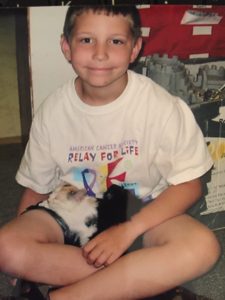By Angel L. Avery-Wright
Pets in child care can be a very rewarding and educational endeavor. Shy, younger children often respond to class pets Children can learn how to care for a pet and how to handle them. Pets needs vary depending on what kind of pet, so children can learn the different ways to care for different animals.
Teachers also need to understand their responsibilities. Pets will need an adult who has the time and understanding to take care of them. Depending on the species, pets will need regular checkups to stay healthy. Food must be purchased and on hand regularly. There is a financial responsibility for the adult who takes care of the pet. Adopting a pet is a lifelong endeavor. Caring for a pet doesn’t end when the school term ends. Someone will need to take the pet home for the summer months if the program is not running.
Risks for pets in child care include allergies, germs and biting. Some children may be allergic to different pets. It is always good to check with parents before introducing a new pet into the classroom. Germs are also a consideration. Children must be taught proper hand washing techniques to reduce the spread of germs. Animals have the potential to bite; their behavior can be unpredictable.
Introducing children to a pet before purchasing one is a good start. Have someone visit with the type of pet you are planning to purchase. Prepare the children for the visit. Explain to children what kind of pet you are getting, what it does, how to hold or touch it, and to always wash your hands after you have touched the pet. Be a good role model.
What kinds of pets are best and what can be done with them?
Fish, birds, reptiles, cats, dogs, hamsters, gerbils, guinea pigs, hermit crabs…where to start?
Fish: Children can feed fish daily, but fish cannot be handled. Tanks may require regular cleaning depending on the type.
Birds: Although parakeets are great pets for school age children and can be held, they can carry air borne diseases that can be passed to humans.

Reptiles/Amphibians: Turtles, lizards, frogs and snakes are not recommended for child care settings, but if you choose one of these make sure proper handling and hand washing
Cats: Cats are great pets, but litter boxes can be an issue in a child care center.
Dogs: Dogs are a bite risk, but come in a large variety of breeds.
Hamsters: Hamsters are low maintenance, but can have a strong smell.
Gerbils: Gerbils are clean but delicate, especially their tails.
Guinea Pigs: Guinea pigs are a popular choice since they don’t smell and are easy to keep.
Hermit Crabs: Crabs can pinch but they are a different type of pet than the norm.
According to the Department of Health Service (DHS), pets are allowed in child care as long as they meet the regulations.
DHS Regulations regarding pets:
- 3270.118. Pets.
(a) A pet or animal present at the facility, indoors or outdoors, shall be in good health and known to be friendly to children.
(b) Contact with pets by the children is permitted only when a staff person is physically present.
(c) A veterinarian’s certificate of current rabies immunization is required for a cat or dog at the facility. The certificate shall be on file when the cat or dog is present.
Cross References
This section cited in 55 Pa. Code § 3270.13 (relating to waivers) and 55 Pa. Code § 3270.241 (relating to requirements specific to school-age programs).
Caring for Our Children (CFOC) also recommends that the pet is trained to be around children, that pets have immunizations but are also on an intestinal parasite control product, and have no signs of fleas or ticks. CFOC also recommends teaching children not to ‘kiss’ the class pet. For more information from the CFOC, visit the website listed in the reference section
References:
http://cfoc.nrckids.org/WebFiles/CFOC3_updated_final.pdf (pages 119-120)
Before you buy a Gerbil – Things to Consider
The Top Birds That Make Great Pets For Kids
10 Reasons Why Guinea Pigs Make Great Pets
Animals in Schools and Daycare Settings


